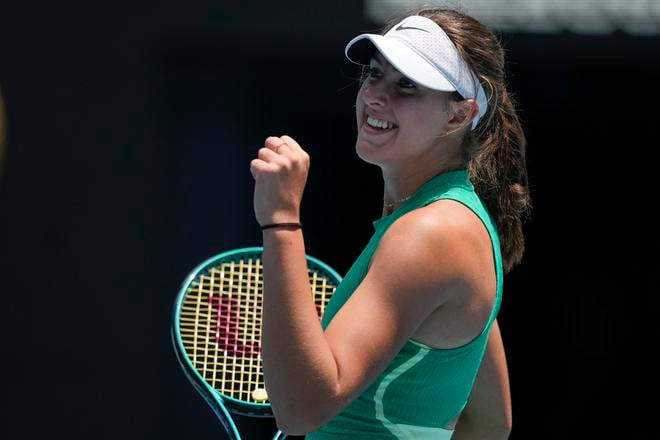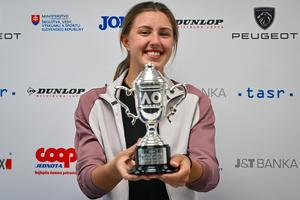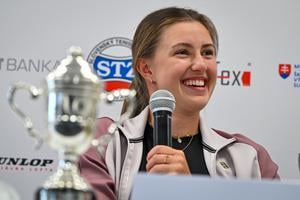In tears after claiming her first Grand Slam girls’ singles title at the Australian Open in late January, Renáta Jamrichová wasn’t only thinking about herself. She walked across the court to sit next to her younger rival, Australian player Emerson Jones, and comforted her.
“We’re friends and I knew how she was feeling. She lost the final in front of her home crowd,” the 16-year-old Slovak said after returning home. “I wanted to tell her that she had also achieved a great result.”
Jamrichová, who’s ranked as the world number one in girls’ singles following her triumph in Melbourne, defeated Jones in two sets, in 61 minutes, even while carrying a stomach-muscle strain. But despite the Slovak having won the girls’ doubles title at last year’s Australian Open, with Federica Urgesi, and also having made it to the semifinals at Wimbledon and the US Open last year, her win still came as a shock to her.
Renáta Jamrichová (16)
born on June 20, 2007 in Trnava
plays tennis with her left hand, has a two-handed backhand
currently holds 1st place in the world junior ranking
at the 2023 Australian Open, she won the doubles title
at the 2024 Australian Open, she won the singles title
her tennis role model is Roger Federer
“I’d lost nearly all the matches during sparring practice with the other girls,” she told Sportnet, The Slovak Spectator’s sports news sister site.
Moreover, she nearly lost to Japanese player Ena Koike in the semifinals in Melbourne. In the end, the Slovak managed to turn the match around and exceed her performances in New York and Wimbledon.
“It was a mini-final for me,” she said about the game against Koike.
The rising tennis star’s latest achievement recalls the success of a previous Slovak former tennis star, Karina Habšudová. In 1991, representing Czechoslovakia, Habšudová won the US Open girls’ singles title and went on to become the world girls’ singles number one. Talented female Slovak tennis players appear once in a blue moon: Jamrichová is only the fourth Slovak player to win a junior singles major, following Tereza Mihalíková, who clinched the same title in Melbourne in 2015, Kristína Kučová, who won the girls’ single title at the US Open in 2007, and Habšudová’s aforementioned success.
Jamrichová’s coach Ján Matúš thinks that the 16-year-old shouldn’t play a senior Grand Slam tournament yet. That may change in 2025. Thanks to her win at the Rod Laver Arena in Melbourne, the main venue for the Australian Open, the same tournament next year could be Jamrichová’s first senior Grand Slam competition.
“For now, the important thing is that she stays healthy and continues to train hard,” Matúš said.
Jamrichová herself seems to be in no hurry. As she has said on several occasions, she enjoys practice more than playing matches (Jamrichová even says that she treats matches as a kind of training) because she can work on herself and experiment.
The classical music composers on her team
Born in Trnava, western Slovakia, the Slovak has always liked doing sports. She was good at cross-country running and swimming, but she also played the piano.
“Still, I needed something extra, so I began playing tennis,” the teenager recalled. It was a friend who showed her the beauty of tennis. “What I liked about it was that every shot was different and I could play whichever I wanted.”
At 13, she decided to focus on tennis. But classical music is something that the player, who remains something of an introvert, hasn’t given up on. She often listens to Mozart, Beethoven and other composers before her matches.
“In this way, I immerse myself in a bit of meditation. It helps me,” she said.
As her third coach, Matúš has trained Jamrichová since she was eight. He is a former primary school classmate of Jamrichová’s mother, who asked Matúš to train her daughter.
“She was a thin little girl with a skilled hand, but she never smiled once during the entire training session. Instead, she was banging the racket on the ground,” her coach said, recalling their first meeting. “But I liked that she was strict with herself and had the right attitude for tennis.”
In a recent interview, she said she had stopped throwing her racket, describing it as an embarrassing habit.
Jamrichová has an ideal figure. She is tall, athletic, mobile, and she can help herself with her serves, tennis experts say. She also has a good hitting technique and plays left-handed. Sometimes looking phlegmatic, Jamrichová is mentally resilient and has learned to not show her frustrations on the court.
“I was still a child at 16. She’s very mature. She has a healthy self-confidence, which a tennis player needs a lot,” said Slovak tennis player Mihalíková. Habšudová also rates Jamrichová’s progress, praising the fact that she doesn’t try to rush anything and doesn’t chase after results and rankings.
“That will come, but right now it’s more important that they improve her game,” the former tennis player said.
Crucially, Matúš says, Jamrichová has finally begun to believe that she can become a top player. This belief in herself is one of the reasons, he added, that she has managed to move up from 232nd place in the world girls’ singles ranking in early 2022 to her current number one spot. Matúš himself has repeatedly said that he’s been convinced of her potential since they started working together.
Now, he wants her to start playing women’s tennis more. She herself is already looking forward to next year’s Australian Open.
“It will definitely be a great experience,” said Jamrichová, who is a fan of Swiss tennis legend Roger Federer.
The Slovak believes that she’s got what it takes to play against women. However, she says that she doesn’t like to set goals for herself when it comes to rankings and trophies. Instead, she considers improving her game and staying healthy to be better goals.
“We’ll see if I can beat them,” she said. It’s the atmosphere at the women’s tournaments that bothers her more. “It is bloodthirsty, unpleasant and tense. I like it when the atmosphere is more friendly.”

She won’t be like Andreeva
Nor does her father have any ambitions in regard to her daughter’s career.
“I just want her to be happy and become a good person,” he told a local TV station.
At present, tennis remains her second highest priority right after her school studies. She attends a private grammar school where her favourite subjects are geography and biology. According to her father, Milan, she’s good at maths and physics.
School is, in part, the reason why the Slovak is not expected to skyrocket into the world of women’s tennis and immediately become a professional like Mirra Andreeva. The Russian player is just 16 years old and is already no. 35 in the WTA – i.e. senior women’s – singles ranking. Jamrichová was no. 811 as of February 5. But the Slovak teenager, who last year already appeared on Forbes’ 30 under 30 list, doesn’t like to be compared to other tennis superstars like Slovak former player Daniela Hantuchová and Czech player Petra Kvitová.
“I don’t think it’s right to make such comparisons. I’m still playing junior tennis,” she explained, adding that she is aware of the high expectations that other people hold of her. “Mine are high, too.”
However, she doesn’t rule out that tennis may cease to fulfil her in the future.
“If the day comes that I’ll be happier doing something else, that I’d rather do something else than go to training, I’ll start doing that.”


 Renáta Jamrichová at the 2024 Australian Open in Melbourne. (source: AP/Louise Delmotte)
Renáta Jamrichová at the 2024 Australian Open in Melbourne. (source: AP/Louise Delmotte)


